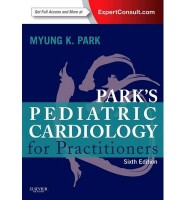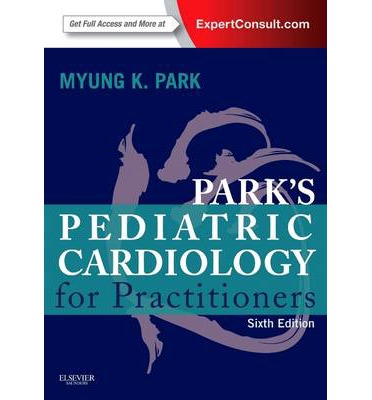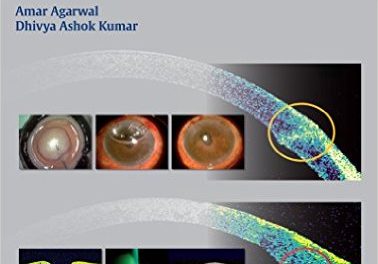 Author: Myung K. Park, MD
Author: Myung K. Park, MD
Publisher: Elsevier Saunders – 676 pages
Book Review by: Nano Khilnani
This is a comprehensive reference book in print, with full text available online, to help you diagnose and manage child and adolescent patients with acquired and congenital heart disease. Among the aspects of pediatric cardiology you will learn from this book are:
- History and physical examination
- Preventive treatment and management of special problems
- Latest concepts in cardiology distilled in a way that is understandable to pediatricians, family practitioners, NPs and Pas alike
- Most recent diagnostic and therapeutic advances in pediatric cardiology, including the latest medical and surgical treatments for all acquired and congenital heart diseases
- Special focus on noninvasive imaging techniques, normative blood pressure standards, and suggested approaches to pediatric hypertension
- Detection and management of lipid abnormalities, as recommended by the Expert Panel, pediatric arrhythmias (including long QT syndrome) and much more.
The book contains 35 chapters on a large range of topics. These are organized under seven Parts, namely:
- Basic Tools in Routine Evaluation of Cardiac Patients
- Special Tools in Evaluation of Cardiac Patients
- Pathophysiology
- Specific Congenital Heart Defects
- Acquired Heart Disease
- Arrhythmias and Atrioventricular Conduction Disturbances
- Special Problems
Reference information is provided in five Appendices namely: Miscellaneous; Blood Pressure Valves; Cardiovascular Risk Factors; Normal Echocardiographic Values; and Drugs Used in Pediatric Cardiology.
Systematic layout of content makes this book very useful for the student and practitioner. An important chapter for example is chapter 2, Physical Examination, where you will go through all the items that must be observed and made note of – a sort of checklist. But what is unique is that the experience and insight of the author shows through in his writing, as he writes in the first paragraph of this chapter:
“As with the examination of any child, the order and extent of the physical examination of infants and children with potential cardiac problems should be individualized. The more innocuous procedures, such as inspection, should be done first, and the more frightening and uncomfortable parts should be delayed until later in the examination.”
“Supine is the preferred position for examining patients in any age group. However, if older infants and young children between the ages of 1 and 3 refuse to lie down, they can be examined initially while sitting on the mother’s laps.”
Among the major topics covered in this chapter on the initial physical of children are:
- Growth Pattern – growth impairment is frequently observed in infants with congenital heart disease.
- Inspection – general appearance and nutritional state, etc.
- Palpation – should include peripheral pulses and the precordium.
- Blood Pressure Measurement – the status of the child at the time of BP measurement such as crying, fighting, and movement – should be considered in the interpretation.
- Auscultation – whereas the bell-type chest piece is better suited for detecting low-frequency events, the diaphragm selectively picks up high-frequency events.
- Some Special Features of the Cardiac Examination of Neonates – normal physical findings (eight are listed in this section) and abnormal physical findings (seven are listed).
To access the online resources, go to www.ExpertConsult.com and do the following:
- Login or sign up
- Scratch off the PIN code on the inside front cover of your book
- Enter the PIN into the Redeem a Book Code box
- Click Redeem
- Go to My Library
Compatible with the PC, Mac, most mobile devices and e-Readers, Expert Consult enables you to browse, search, and interact with this title – online and offline. Here are some of the benefits:
- Seamless, real-time integration between devices
- Straightforward navigation and search
- Notes and highlights sharing with other users through social media
- Enhanced images with annotations, labels, and hot spots for zooming on specific details*
- Live streaming video and animations*
- Self-assessment tools such as questions embedded within the text and multiple-format quizzes (* some features vary by title).
Another set of online resources is available to you on www.ClinicalKey.com. Go to the inside back cover of your book to read the benefits available to you.
For better patient care, you can do smart and fast searches for information on the above-mentioned site. Unlike a conventional search engine, ClinicalKey is specifically designed to serve doctors by providing three core components:
- Comprehensive Content – the most current, evidence-based answers available for every medical and surgical specialty.
- Trusted Answers – content supplied by Elsevier, the world’s leading provider of health and science information.
- Unrivaled Speed to Answer – faster, more relevant clinical answers, so you can spend less time searching and more time caring for patients.
This is a reasonably comprehensive textbook on the many cardiac problems and issues that children have and is a leading one in this particular medical specialty.
Myung K. Park, MD, FAAP, FACC is Professor Emeritus of Pediatric Cardiology, former Director of Pediatric Cardiology, and former Medical Director of Pediatric Preventive Cardiology and Weight Management Clinics at the University of Texas Health Science Center in San Antonio, Texas.







